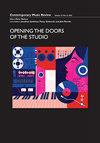有什么意义?在基于规则的构图中平衡目的和玩法
IF 0.1
2区 艺术学
0 MUSIC
引用次数: 0
摘要
本文将游戏研究中的理论应用于音乐创作,以考虑规则和目标如何创造促进批判性游戏的环境,并管理目的、游戏和任务服从之间的平衡。它探索了游戏规则和不确定音乐之间的对应关系,并考虑了约束如何通过向玩家提供与价值观相关的选择和目标来为玩家创造代理。游戏研究表明,游戏依赖于互动性、目标、竞争对手和冲突(Crawford 2003),从而依赖于玩家的努力,从而重视其结果(Juul 2003)。在基于规则的构图中,规则用于呈现选择,允许单个玩家做出专注于实现特定目标的自主决策。然而,一些基于规则的组合指定了没有明确目的的过程和操作。一个过程是启动的,可能有一个结束条件,但除了承担任务之外,没有特定的目的。游戏研究表明,在这种情况下,游戏可能会创造出利用玩家特定动机的方法。说服性游戏中的任务(Bogot 2010)旨在体现现实世界的挑战,而Flanagan和Nissenbaum(2014)提出了一种传达嵌入价值观的游戏设计方法。这种方法转化为基于规则的音乐,提供了将任务与目的和游戏以及与世界的关系联系起来的模型。本文章由计算机程序翻译,如有差异,请以英文原文为准。
What’s the Point? Balancing Purpose and Play in Rule-based Compositions
The paper applies theory drawn from game studies to music composition in order to consider ways in which rules and goals create environments that promote critical play and manage the balance between purpose, play and task subservience. It explores correspondences between rules in games and indeterminate music, and considers how constraints create agency for players through presenting them with choices and goals that can be linked to values. Game studies research shows that games rely on interactivity, goals, competitors and conflict (Crawford 2003), and consequently effort from its players so as to attach value to its outcomes (Juul 2003). In rule-based compositions, rules are used to present choices, allowing individual players to make autonomous decisions that are focused on achieving a specified goal. Some rule-based compositions, however, specify processes and actions that have no explicit purpose. A process is initiated, perhaps with an end condition, but there is no specified purpose, other than undertaking the tasks. Game studies research suggests ways in which games might create approaches for harnessing specific motivations of players in such contexts. Tasks in persuasive games (Bogost 2010) are designed to embody real-world challenges, while Flanagan and Nissenbaum (2014) propose an approach to game design that communicates embedded values. Such approaches translate to rule-based music, presenting models for linking tasks to purpose and play, and with it relationships with the world.
求助全文
通过发布文献求助,成功后即可免费获取论文全文。
去求助
来源期刊

Contemporary Music Review
MUSIC-
CiteScore
1.00
自引率
25.00%
发文量
48
期刊介绍:
Contemporary Music Review provides a forum for musicians and musicologists to discuss recent musical currents in both breadth and depth. The main concern of the journal is the critical study of music today in all its aspects—its techniques of performance and composition, texts and contexts, aesthetics, technologies, and relationships with other disciplines and currents of thought. The journal may also serve as a vehicle to communicate documentary materials, interviews, and other items of interest to contemporary music scholars. All articles are subjected to rigorous peer review before publication. Proposals for themed issues are welcomed.
 求助内容:
求助内容: 应助结果提醒方式:
应助结果提醒方式:


